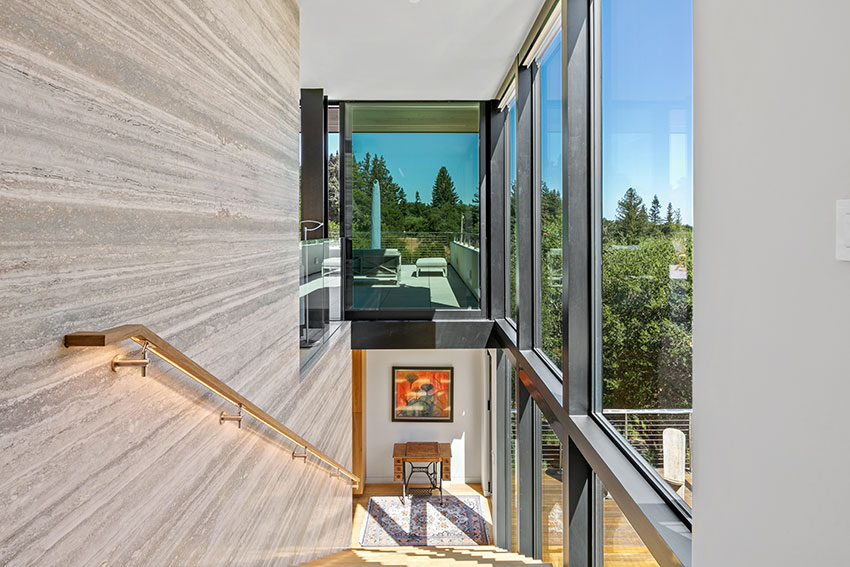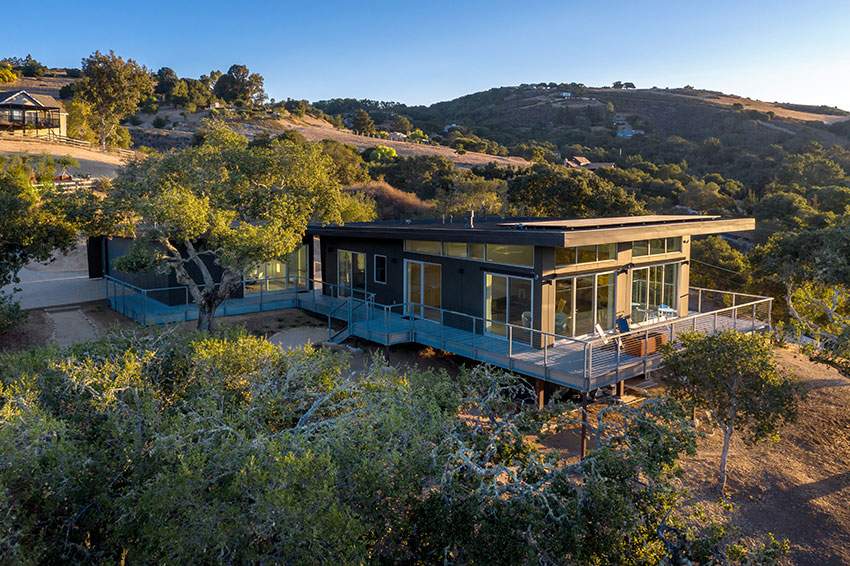Specifying Aluminum High-Performance Windows and Doors
U-factors for the 2021 IECC had significant changes from the 2018 version. Aluminum windows and doors can meet the thermal requirements of all these codes with an increased use of thermal breaks and upgraded glazing strategies. In addition, they can satisfy all daylighting requirements. Daylighting is also becoming a more important consideration as there is a steadily rising focus on occupant health and well-being in building design and certification.

Photo courtesy of Tour Space
The Greenwood Residence features a window system with high energy-efficiency ratings and a glazed solution for residential applications and buildings of up to 12 stories.
Thermal Performance of Insulated Glass Units
There have been recent advances in thermal barriers that meet these increasingly stringent energy reduction goals. These include polyamide struts and wide-cavity, dual-pour, and debridged polyurethane thermal barriers. These types of barriers will be explained in greater detail later on in this course. In addition, aluminum thermal barrier technology is making further advances to work more closely in conjunction with glass, glazing, and envelope materials to reduce commercial building energy consumption.
Current technology with standard thermal breaks has improved aluminum frame U-factors from roughly 2.0 to about 1.0. Innovative new thermal break designs have been combined with changes in frame design to achieve U-factors lower than 0.5 but at a higher cost than current thermally broken frames. The higher capital cost of the frames, however, can be recovered over time in energy savings.
Glazing performance can be equal to or greater in importance than the frame, which should then be designed to accommodate the best glazing solution. In the Empire State Building energy retrofit described earlier, the opposite occurred. Because of the desire to retain the existing aluminum window frames, which previously held double glazing with a steel spacer, the retrofit glazing strategy created glazing to fit into these frames. The solution was double glazing with a high-performance E-coating, a suspended heat mirror film, inert gas, and warm-edge spacers to double or quadruple the overall performance of the windows within the existing frames.
Double- and triple-pane windows and doors are now often filled with inert gases such as argon or krypton to reduce convection within the units and to improve the window or door’s overall energy efficiency. These gases are often known to leak—many times at just a rate of just 1% a year, which is generally acceptable. However, sometimes if the seals are not sufficient, they will leak faster, thus ruining their contribution toward energy efficiency and necessitating an expensive replacement. Aluminum can be fabricated to extremely close tolerances to create precise forms for the insertion of glazing, weatherstripping, and thermal barriers to control this leakage.

Photo courtesy of David Lalush
Packed with off-grid tech, the three-bedroom, three-bath Waterfall Residence soaks up stunning views of Carmel Valley. Andrew Goodwin Designs collaborated with the homeowners who are seasoned industrial designers on the final structure. Dual-glazed sliding doors and windows frame views of the landscape and flood the interior with natural light.
Glazing Options
It is not the intent of this course to provide a full analysis of each type of glazing material or system; the goal is simply to list the materials and describe them briefly to assist the designer in selecting the appropriate one.
Clear Glass
Clear glass is the most commonly used type of glass. It has high visible light transmittance and reasonable color neutrality. It is widely used because of its low cost, due to its use of recycled material and is an excellent substrate for high performance low-E coatings. Clear glass is essentially invisible.
Low-E Coat
Low-E (emissivity) coatings reduce heat gain from the sun and restrict the amount of ultraviolet and infrared light passing through glass without compromising the amount of visible light transmitted. In colder climates, passive coatings reflect long-wave energy from the building interior back into the building, thus minimizing the amount of heat passing through to the outside. In hot climates, low-E coated glass blocks solar heat energy and provides thermal insulation. This keeps cool air inside and hot air outside.
Safety Glass
Annealed Glass (also called nontempered, float, or standard glass) The annealing process improves the glass’s durability and helps to reduce internal stresses that could result in breakage. Annealed glass is often used in items such as tabletops, cabinet doors, and basement windows. It is not as strong as tempered glass.
Tempered Glass
Tempered glass is annealed glass that has been heat treated to harden and strengthen it. Tempered glass is one of the hardest types of glass available. It is up to five times harder than most other glasses, including annealed glass. It cleans very easily and, if installed properly, will not augment glare or affect colors, image quality, or sharpness.
Laminated Glass
This glass is one step higher as a safety glass. It is made by adhering two pieces of annealed glass together with a vinyl layer. The vinyl layer holds the glass together if the glass is broken or impaled.
Other Glass Options
Tinted Glass
Tinted glass is used to add color to projects. Tints are also beneficial for reducing glare and limiting solar heat gain when used in conjunction with low-E coatings. Tinted glass can be laminated, tempered, or heat-strengthened to satisfy strength or safety requirements.
Low-Iron Glass
Low-iron glass is made with a low-iron formulation that improves its levels of clarity, transparency, and color accuracy when compared to clear glass. This can significantly impact daylighting because it can provide the same amount of daylight in smaller areas as clear glass does in larger areas but without the same amount of heat loss/gain.
Spandrel Glass
Spandrel glass is opaque and can hide features between the floors of a building. Spandrel glass should be heat-strengthened to resist the thermal stresses associated with potential heat absorption and buildup behind it. There are various types of spandrel glass units available, and they include insulated units.
Further Performance Factors
In relation to the window or door as a whole, there are a number of other performance factors that the designer should assess in order to gauge future performance.
- U-Factor: the rate of heat transfer (heat gain or loss) through glass; the lower the U-factor, the better
- R-Value: the measure of heat resistance, the ability of a material to reduce the transfer of heat; the higher the number, the better
- Solar Heat Gain Coefficient: how well a product can resist heat gain; the lower the number, the better
- Visible Light Transmittance: how well a product will admit natural light; the higher the number, the better
- Air Leakage: how much unwanted air will enter a space through a window assembly; the lower the number, the better; less air leakage means a lower amount of drafts will be experienced and occupant comfort and health will be improved.
- Water Infiltration: how much water will infiltrate a window assembly from real-life weather events or wind-driven rain in a given amount of time, typically tested according to ASTM E1105
- Daylight Opening: the total viewing area available in any window or door, which affects daylighting, view, and energy performance as well as building aesthetics. Structural ratings are composed of two parts: deflection measurements and overload pressure.
- Deflection is measured by loading the window/door to the design pressure, and the amount of deflection at the center of the mullion is measured under wind loading..
- Overload pressure: Once the first portion of structural testing is complete, overload testing to 1.5 times the design pressure is done. The window or door must still stay intact without major deformation and be in working condition after testing is complete.









